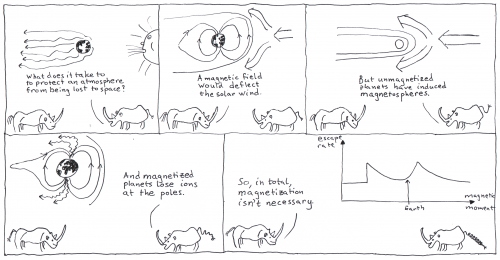Background
Whether or not a planet has a magnetic field determines how it interacts with the solar wind and what the available paths for atmospheric escape are.
Magnetospheres form both around magnetised planets, such as Earth, and unmagnetised planets, like Mars and Venus, but it has been suggested that magnetised planets are better protected against atmospheric loss. However, the observed mass escape rates from these three planets are similar (in the approximate 0.5-2 kg/s range), putting this suggestion into question.
Our results
We model the effects a planetary magnetic field has on the major atmospheric escape processes, showing that the escape rate can be higher for magnetised planets over a wide range of magnetisations due to escape of ions from the polar regions, where the magnetic field lines connect the ionosphere to interplanetary space.
The end result is that, contrary to what has previously been believed, magnetisation is not a sufficient condition for protecting a planet from atmospheric loss.
The reasons for this result are that:
- both magnetised and unmagnetised planets are protected by magnetospheres
- while a magnetic field offers better protection from some escape processes, it enables others that are not available at unmagnetised planets.
Reference
- Gunell, H., Maggiolo, R., Nilsson, H., Stenberg Wieser, G., Slapak, R., Lindkvist, J., Hamrin, M., De Keyser, J. (2018). Why an intrinsic magnetic field does not protect a planet against atmospheric escape. Astronomy & Astrophysics, 614, L3. https://doi.org/10.1051/0004-6361/201832934


